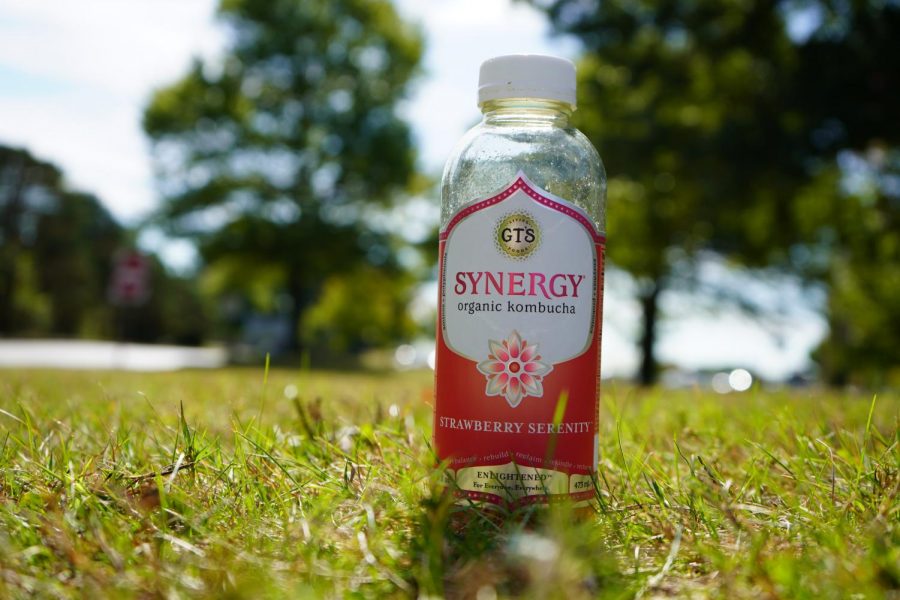Kombuch-ya!
What’s this hipster craze all about?
The origins of Kombucha are mysterious. But to fans of the unusual beverage, the benefits are beyond debate.
October 16, 2019
Those who have taken Psych will know about the “Reactance Theory”, which is the tendency of good people to act poorly in response to rules and feel great about doing so. Whether that’s just an excuse, rationalization bad behavior, I cannot say. But, when I walk into school with my ever-so-slightly alcoholic kombucha, I won’t deny that I feel alive--then again, that might be the 4 million probiotic organisms crawling along my tongue.
Hopefully, though, in mentioning kombucha and rule-breaking in the same paragraph, I haven’t directly correlated the two. After all, that is a common misconception: those who drink kombucha are man-bun-wearing, drug-using, Antifa-praising social anarchists who turn a cold shoulder to authority and the traditional values that hold our country together. This is, of course, mostly untrue–although I do wear a man-bun.
To really understand the truth about kombucha drinkers, it’s imperative to first understand the story of kombucha, an epic tale that spans two millennia and three continents. Dating the birth and path of kombucha is as much about defining the effervescent tea as it is about actually tracing its lineage. The first accepted use of the word “kombucha” comes from the Far East, just over two thousand years ago. Unfortunately for kombucha-lovers like me, the trail diverges into multiple paths from there.
One suggested origin story, and my personal favorite, gives credit to Korea. In this legend, a court physician, Dr. Kombu, used the fermented tea to heal the sitting “Legendary Emperor” Inyko in 400 AD. The Emperor was not only miraculously healed but also revitalized and revivified by the tea. To honor the physician, Inyko named the tea after him: “Kombu” and “Cha”, meaning Kombu’s Tea.
There are also possible derivations from both Japan and China, though each story describes a drink far from the kombucha we know today. The Japanese legend describes a “kelp tea” in the early 200s AD, made of dried kelp powder, called “konbu”. In this way, the Japanese version of the tea is far more like matcha than anything else. The Chinese legend is even less detailed, simply describing a fermented “tea of immortality” that the Emperors of the Tsin Dynasty drank for good health.
The first reputable emergence of modern kombucha–in that it was a black or green, effervescent tea fermented with sugar– is from Russia. The tea was brewed much like it is today, with a SCOBY (symbiotic culture of bacteria and yeast), a considerable amount of sugar, and plenty of patience. The Russian kombucha was first drunk in the 1500s but wasn’t introduced to western culture until the early 20th century with the conclusion of World War II. Between the Battle of Stalingrad and the other skirmishes of Operation Barbarossa, the USSR amassed more than 3 million German POWs. When prisoners were released throughout the 50s, they brought tales of SCOBY and fermented tea to Western Europe as “Kombuchaschwamm”. There, it was used as a yogurt substitute and medicine for both PTSD and cancer patients–imagine that. But, while that’s perhaps the most legitimate origin story, it’s still a far cry from the hipster drink sitting on the shelves of Whole Foods. So how did kombucha go from a Japanese royalty drink to a Nazi POW homecoming gift to a trendy health drink? What else but the 90s?
The world’s current largest supplier of kombucha is GT’s Living Foods, a company valued at just short of $1 billion. The founder, George Thomas Dave, started brewing kombucha in 1995 with a loan from his mother–after whom the company’s logo is modeled. Moreover, Dave’s inspiration for starting his brand was his staunch belief that his homebrewed kombucha cured his mother’s breast cancer and helped his friends survive AIDS. There is, of course, no real evidence behind these magical health supplements, but that doesn’t necessarily diminish the validity of GT’s, or any other company’s, kombucha.
Like the origins of kombucha itself, its drinkers can’t be pinned to a single area or people. In honesty, we’re more like the SCOBY than anything else. Kombucha-drinkers form a semi-tangible culture of living things, each person an independent living and breathing organism clinging to the group– some for its mythical health benefits, some for the sake of being “hip”, and even others simply for the taste. There are dreadlocked communists brewing unregulated kombucha in the mountains of Colorado, but there are also businesswomen and plumbers, politicians and migrant workers who all enjoy the drink. It’s the reason PepsiCo bought Kevita, a probiotic drink supplier, for more than $200 million in 2016, and it’s the reason I will always defend the microorganisms who can’t defend themselves.













